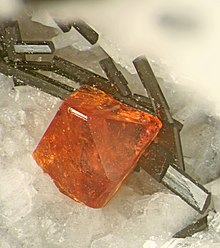Ferrokentbrooksite
Ferrokentbrooksite is a moderately rare mineral of the eudialyte group,[1] with formula Na15Ca6(Fe,Mn)3Zr3NbSi(Si3O9)2(Si9O27)2O(O,OH,H2O)3(Cl,F,OH)2.[2] The original formula was extended form to show the presence of cyclic silicate groups and presence of silicon at the M4 site, according to the nomenclature of eudialyte group.[3] As suggested by its name, it is the (ferrous) iron analogue of kentbrooksite.[2] When compared to the latter, it is also chlorine-dominant instead of being fluorine-dominant.[1] The original (holotype) material is also relatively enriched in rare earth elements, including cerium and yttrium.[2]
| Ferrokentbrooksite | |
|---|---|
 Ferrokentbrooksite, Amphibole Supergroup-166795 | |
| General | |
| Category | Cyclosilicate |
| Formula (repeating unit) | Na15Ca6(Fe,Mn)3Zr3NbSi25O73(O,OH,H2O)3(Cl,F,OH)2 (original form) |
| Strunz classification | 9.CO.10 (10 ed) 8/E.23-15 (8 ed) |
| Dana classification | 64.1.2.2 |
| Crystal system | Trigonal |
| Crystal class | Ditrigonal pyramidal (3m) H-M symbol: (3m) |
| Space group | R3m |
| Unit cell | a = 14.25, c = 30.03 [Å] (approximated); Z = 3 |
| Identification | |
| Color | Reddish brown to red |
| Crystal habit | pseudo-octahedra |
| Cleavage | No |
| Fracture | Uneven to conchoidal |
| Luster | Vitreous |
| Streak | White |
| Diaphaneity | Transparent |
| Refractive index | nω 1.62, nε=1.62 (approximated) |
| Common impurities | REE (mainly Ce and Y), K, Sr |
| References | [1][2] |
Occurrence and association
Ferrokentbrooksite was discovered in Mont Saint-Hilaire, Quebec, Canada - a site wealth in rare alkaline minerals.[4] At the site ferrokentbrooksite coexists with aegirine, albite, ancylite-(Ce), calcite, catapleiite, fluorite, fluorapatite, gonnardite, microcline, natrolite, nepheline, rhodochrosite, and serandite.[2]
Notes on chemistry
Beside fluorine, ferrokentbrooksite has admixtures of rare earth elements (including cerium, yttrium, lanthanum, neodymium and some gadolinium and samarium), potassium, strontium, and contains minor admixtures of titanium, hafnium, and tantalum.[2]
Notes on structure
Iron in ferrokentbrooksite has coordination number 5.[2]
References
- Mindat, Ferrokentbrooksite, http://www.mindat.org/min-7106.html
- Johnsen, O., Grice, J.D., and Gault, R.A., 2003: Ferrokentbrooksite, a new member of the eudialyte group from Mont Saint-Hilaire, Quebec, Canada. The Canadian Mineralogist 41(1), 55-60
- Johnsen, O., Ferraris, G., Gault, R.A., Grice, D.G., Kampf, A.R., and Pekov, I.V., 2003. The nomenclature of eudialyte-group minerals. The Canadian Mineralogist 41, 785-794
- "Poudrette quarry (Demix quarry; Uni-Mix quarry; Desourdy quarry; Carrière Mont Saint-Hilaire), Mont Saint-Hilaire, La Vallée-du-Richelieu RCM, Montérégie, Québec, Canada - Mindat.org". Mindat.org. Retrieved 2016-03-11.